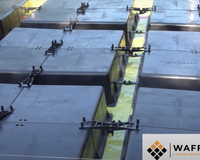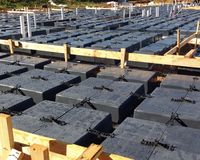A Climate Change Gas Emissions Analysis on the Production, Transportation, and Use of Concrete in Slab Foundations
Sam L. Altshuler | State of California P.E., M.E. | Board Certified Environmental Engineer
“Use of the Wafflemat foundation-forming system in residential home construction can reduce the level of climate change emissions by 20% [the equivalent of 4 to 9 tons less CO2 released into the atmosphere of an average 1,800 sf home] when compared to the use of conventional slab foundations. Other emissions reductions are also projected.
Executive Summary
Carbon dioxide (CO2) is the main anthropogenic gas contributing to the buildup of greenhouse gases in the earth’s atmosphere. Emissions of CO2 from a specific project are collectively referred to as the “carbon footprint.” CO2 emissions result from use of fossil-derived energy during the production and transport of materials.
The following is an assessment of the reduced carbon footprint resulting when a typical amount of concrete is used in the foundation of an average-sized residential home vs. when Wafflemat is utilized.
Today’s Regulatory Environment
Before considering any analysis, it’s helpful to have a general understanding of today’s regulatory environment. Globally, the 1997 Kyoto Protocol is an agreement made under the United Nations Framework Convention on Climate Change (UNFCCC) in which participating countries commit to reduce emissions of carbon dioxide and five other greenhouse gases (methane, nitrous oxide, sulfur hexafluoride, HFCs, and PFCs) beginning in 2005 by 5.2% compared to those of 1990 (but note that, compared to the emissions levels that would be expected by 2010 without the Protocol, this target represents a 29% cut). National targets range from 8% reductions for the European Union, to 7% for the US, 6% for Japan, and permitted increases of 8% for Australia and 10% for Iceland.
In the US, individual states have legislated requirements for local emissions. For example, California (the world’s 12th largest source of carbon dioxide) recently adopted Assembly Bill 32, requiring the state’s emissions be reduced to year 2000 levels by 2010, year 1990 levels by 2020, and 80% below year 1990 levels by 2050. This will be accomplished through an enforceable statewide cap on emissions. In addition, and in order to effectively implement the cap, AB 32 directs the California Air Resources Board (CARB) to develop appropriate regulations and establish a mandatory reporting system to track and monitor emissions levels.
Emissions Estimate Analysis
Portland Cement
According to US EPA AP-42, the CO2 emissions from Portland Cement Manufacturing are generated by two mechanisms. As with most high-temperature, energy-intensive industrial processes, combusting fuels to generate process energy releases substantial quantities of CO2. Additional, and again often substantial, quantities of CO2 also are generated through calcining of limestone or other calcareous material. This calcining process thermally decomposes CaCO3 to CaO and CO2. Typically, Portland Cement contains the equivalent of about 63.5 percent CaO. Consequently, about 1.135 units of CaCO3 are required to produce 1 unit of cement, and the amount of CO2 released in the calcining process is about 500 kilograms (kg) per Mg produced (1,000 pounds [lb] per ton of cement). Total CO2 emissions from the pyro process depend on energy consumption and generally fall in the range of 0.85 to 1.35 Mg of CO2 per Mg of clinker.
Once cement is manufactured, it’s mixed with fine & coarse aggregate and sand to make concrete. In the United States, it’s not uncommon for residential concrete to be designed with a water/cement ratio of 0.45.To meet this specification, concrete will contain 519 to 639 pounds of cement per cubic yard depending on the amount of substitutes (such as fly ash) utilized for cement. Concrete weighs 3996 lbs/cubic yard, or about 2 tons per cubic yard.
Combining the data, a range of 440 to 862 pounds (0.22 to 0.43 tons) of CO2 emissions are generated per cubic yard of concrete during its production. Concrete with a high fraction of substitutes, produced in a more efficient facility, will have the lower CO2 emission rate.
Transportation of Concrete
Each gallon of diesel fuel consumed in the transport of concrete emits 22.6 pounds of CO2 when using petroleum derived diesel fuel (in contrast to biodiesel). Total CO2 emissions – wellhead to wheel – are
about 20% higher depending on refinery location and efficiency, or about 27 lbs/gallon. Cement is transported to a concrete batching facility in cement bulk tankers. A cement tanker hauls approximately 26.5 tons of cement in a load, and the truck averages about 6 mpg. The average round trip to haul cement is approximately 150 miles. Aggregates are transported in various haul trucks. The average delivery is 25 tons, and the average round trip is 40 miles. Concrete is hauled in a specialized concrete mixer truck. Because of the excessive idle time, a concrete mixer truck averages about 4 mpg. The average load in a concrete truck is approximately 8.5 cubic cy. Combining the CO2 emissions for various elements of transportation needed for production and delivery of the concrete to the job site results in about 34 to 35 lbs (low cement fraction vs. high cement fraction) of CO2 per cubic yard of concrete.
Other Attributes
Beyond the reduction in CO2 emissions, reduction in oxides of nitrogen (NOx), particulate matter, hydrocarbons, and carbon monoxide would also occur. These could be quantified as well, but would track and correlate to the predicted reduction in CO2.
CO2 Emissions Totals
The manufacture and transport of cement/concrete to a job site results in 474 to 897 lbs (0.24 to 0.45 tons) of CO2 per yard of concrete. The majority of CO2 comes as a result of the production of cement for the concrete with a significantly lesser amount contributed by transportation of the material.
Conclusion
Comparisons of numerous floor plans have shown, on an average 1,800 – 2,000 sf home, the Wafflemat foundations-forming system typically reduces the use of 5 – 40 yards of concrete (depending on size of any interior beams utilized) when compared to an equivalent Ribbed or 10” Uniform Thickness Foundation (UTF) slab. Assuming20 yards of reduction, corresponding CO2 emissions would be reduced by 4.8 to 9.0 tons, or about 20% lower than conventional slab foundations.
In other words, CO2 emissions reduced when using the WAFFLEMAT System are equivalent to those emitted when using 405 to 766 gallons of gasoline (23.4 lbs/gal, full fuel cycle), or enough fuel to drive an automobile averaging 35 MPG 14,000 to 27,000 miles.
Summary
Use of the Wafflemat in residential home construction can reduce the level of climate change
emissions by 20% in an average 1,800 sf home – the equivalent of 4 to 9 tons less CO2 released into the atmosphere – when compared to the use of conventional slab foundations. Other emissions reductions are also projected.
References
· United States EPA AP-42, January 1995
· WAFFLEMATTM , US Patent 5,540,524, 1996
· Kyoto Protocol, UNFCCC, December 1997
· California Assembly Bill 32, December 2006
Contributing
Joe Sostaric, President, RS Solutions LLC





